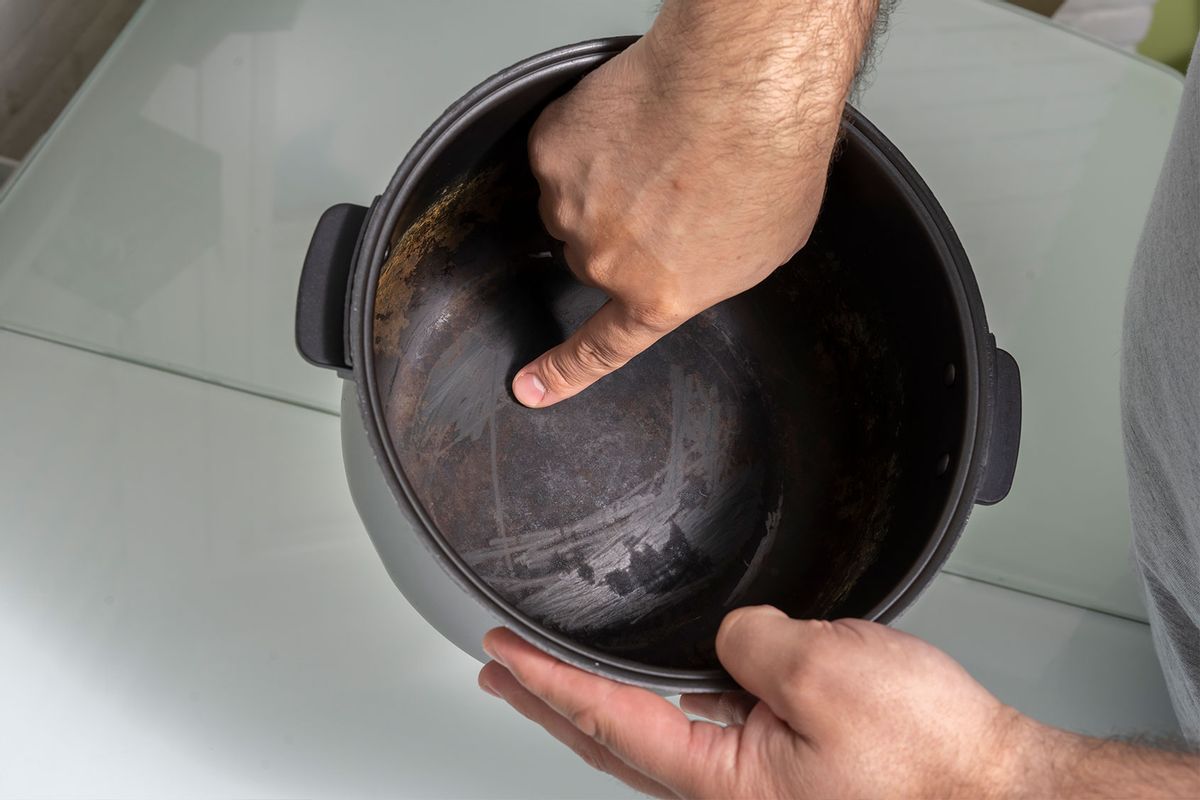A new study counted the number of microplastic contaminants that emerged from a cracked nonstick pan
Everyone knows the name Teflon, the patented nonstick coating chemical discovered by DuPont in 1938 — which is convenient because the full name for the type of synthetic polymer that includes Teflon, "per- and polyfluoroalkyl substances" (PFAS), is quite the tongue-twister. Although such cookware is beloved by cooks for making cleaning easier, Teflon and other so-called "forever chemicals" in non-stick pans have been turning up in human bodies, and are linked to ailments ranging from high blood pressure and low sperm count to liver disease. It stands to reason that consumers would like PFAS such as Teflon to stay on their cookware and off their food, even though anyone who has prepared a meal knows that does not always happen.
Now, a new study in the journal Science of the Total Environment reveals that a single surface crack in the teflon coating of a frying pan can eject as many as 9,100 plastic particles, more than enough to enter the human body.
Like the chemicals they studied, the scientists behind this breakthrough hail from an organization whose name is a mouthful. Researchers from the Global Centre for Environmental Remediation and Flinders Institute of NanoScale Science and Engineering used Raman imaging and an algorithm model to visualize microplastics and nanoplastics alike on a microscopic scale. Using this data, they identified that 2.3 million microplastics and nanoplastics were released when a frying pan's teflon coating is broken.
"The non-stick coating material Teflon is generally a family member of PFAS," University of Newcastle researcher Dr Cheng Fang, who was involved in the study, said in a press statement. "Given the fact PFAS is a big concern, these Teflon microparticles in our food might be a health concern [and] needs investigating, because we don't know much about these emerging contaminants."
Flinders University researcher Professor Youhong Tang added in the statement that the study is a warning about the danger of not cooking in a safe way. Notably, most nonstick pans have instructions that say not to heat them above medium, though the great variation in home stoves means that even rule-following home cooks might not always succeed at keeping such pans from emitting odorless fumes that have been known to kill birds in poorly ventilated rooms.
"It gives us a strong warning that we must be careful about selecting and using cooking utensils to avoid food contamination," Tang said in the statement. "More research is recommended to address the risk assessment of the Teflon microplastics and nanoplastics, given that Teflon is a family member of PFAS."
In addition to appearing on cooking pans, PFAS can be found in fast food wrappers, popcorn bags and countless other types of commonly-used kitchenware. They are literally inescapable, and that is why the American Heart Association journal Hypertension was so alarmed in June when it studied 1,000 middle-aged women and discovered that "women with higher concentrations of specific PFAS were more likely to develop high blood pressure." More specifically, "women in the highest one-third concentrations of all seven PFAS examined had a 71% increased risk of developing high blood pressure," the study found. High blood pressure can lead to heart attacks and strokes if left untreated.
In another study that isolated seven common PFAS, a report last month in the journal Environmental Health Perspectives found that when pregnant mothers in their first trimester were exposed to a mixture of those PFAS, their biologically male children wound up having "lower sperm concentration, lower total sperm count, and higher proportions of nonprogressive and immotile sperm in young adulthood." Meanwhile a systematic review of scientific literature published in May by the journal Environmental Health Perspectives revealed that there is "a relationship between higher exposure to certain PFAS chemicals and higher blood levels of ALT," or the liver enzyme Alanine Aminotransferease. Study author Liz Costello told Salon at the time that the enzyme is "a good indicator of liver injury." Costello also commented on the ubiquity of PFAS.
"It's very difficult for individuals to control their PFAS exposure – PFAS are in so many products (and water, or food) and often we don't even know we are exposed," Costello explained. "Even when older PFAS are phased out and no longer used, newer PFAS chemicals replace them. You won't usually see these listed on a product label."
- Karlston
-

 1
1



Recommended Comments
There are no comments to display.
Join the conversation
You can post now and register later. If you have an account, sign in now to post with your account.
Note: Your post will require moderator approval before it will be visible.